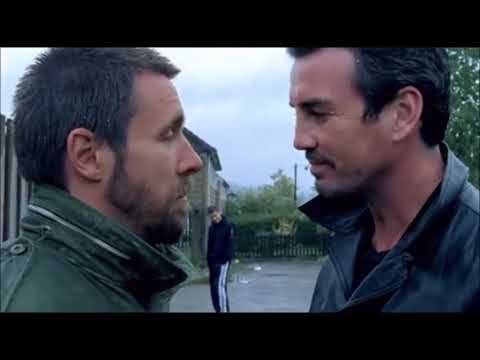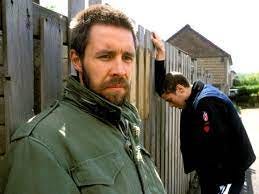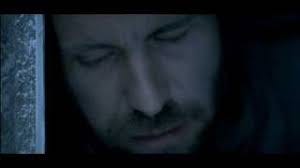Dead Man’s Shoes remains one of the most affecting and visceral films of the 2000s. Directed by Shane Meadows and starring Paddy Considine as Richard, the sleepy northern town of Matlock in Derbyshire acts as the backdrop for this tale of revenge and redemption. The opening scenes intersperse grainy family video recordings with Richard traversing the fields and pathways of the Derbyshire countryside, carrying a military style khaki bag, and flanked by his younger brother Anthony played by Toby Kebbel. Bill Callahan’s song Vessel in Vain plays gently over the opening foreshadowing the events to come. The lines, My ideals have got me on the run/such a free reign/for a vessel in vain are highly prescient. Anthony has become a vessel for vengeance, a response to the death of his bullied and abused younger brother Anthony at the hands of a local drug dealing gang.
Considine’s opening lines of narration set an ominous tone as an immediate counterpoint to the preceding beauty of the countryside: God will forgive them. He’ll forgive them and allow them into heaven. I can’t live with that. Meadows establishes the visual tropes of the great Western director John Ford from the outset, framing the exterior landscape through an interior doorframe. In this case, it is the rolling hills of Derbyshire that are framed not the Arizona plains. Dead Man’s Shoes shares the same thematic DNA as Ford’s classic The Searchers (1956) starring John Wayne. Wayne plays Ethan Edwards, a Civil War veteran who exacts revenge on Native American Indians who killed his family. Considine’s Richard is on his own mission of violence - his wrath about to be unleashed on to the unexpecting petty criminals of his hometown.
The film’s success hinges on the central performance of Considine. If the character was slightly off-pitch it simply would not have worked. The screenplay was co-written by Meadows and Considine who had worked on short films previous to Dead Man’s Shoes. Considine embodies the character in a very literal sense. His presence is all- encompassing on screen. His slightly unhinged yet massively controlled performance is often chilling. The character’s past as an experienced soldier is believable in the economy with which Considine behaves but also the bursts of highly skilled violence which he enacts on the unsuspecting petty criminals who were responsible for his younger brother’s ultimate suicide.
A scene which sees Richard square off with the gang leader Sonny on a pavement is a perfect example of the sheer power of Considine’s portrayal of Richard. He possesses a quiet intensity that is rare in the world of acting. DeNiro in Raging Bull (1980) or Brando in On the Waterfront (1954) would be two other performances which seem to be imbued with a similar level of masculine intensity. There is a fearlessness coupled with a complete sense of control which culminates in this scene on the side of the street. Richard is unflappable when face to face with Sonny. It satisfies that very human need for self realisation, to prove ourselves in the face of great adversity. Sonny represents all those who have wronged us, abused us or beaten us, whether that be physical or figurative. We are all Richard in this scene.
The leader of the bungling gang is Sonny played by Gary Stretch. Stretch was a world champion welterweight boxer with an impressive record of 29 wins and 1 loss. It is remarkable that this was one of his first major roles in a feature film. His menacing and sadistic portrayal of Sonny acted as the perfect foil for Considine’s character Richard. For the audience to be brought along with Richard’s ultra violence, there needed to be a clear motivating factor. Through a series of flashbacks, differentiated from the present time in black and white, Sonny’s levels of moral depravity and cruelty are depicted close up and in detail. Meadows plays on our natural human instincts of empathy and in equal measure our innate need for some form of retribution. We are horrified at the treatment of Anthony as he is highly vulnerable - he has learning difficulties. This adds the necessary layer of disgust which emotionally liberates the viewer of conversely attributing any sense of revulsion to the actions of Richard. The narrative ground has been prepared for the viewer to be with Richard. It plays on our most Freudian basic instincts - aggression and violence.
Toby Kebbel made his debut in this film playing Anthony. He was a last minute replacement for the previous actor who felt he could not genuinely portray the character’s intellectual difficulties. Kebbel does a remarkable job depicting this aspect of Anthony’s character. Playing characters with special needs has a history of either great successes (My Left Foot) or abject failures (I am Sam). Kebbel’s performance can be firmly placed in the former category. His sympathetic and understated approach to the character of Anthony further strengthens the viewer’s investment with his brother Richard who is essentially committing mass murder. This is a testament to the sophistication of both the screenplay but also the direction of Meadows.
Despite the grimness of the film, there is a strong undercurrent of dark comedy present. Richard initially announces his presence to the gang through some comical night-time visitations to their homes. He paints Sonny’s face in clown style make-up as he sleeps. On the same night, while in a drunken state of unconsciousness, he paints the hair of another henchman purple and writes the word ‘git’ on the back of another’s jacket. The comedic payoff comes the next morning when Sonny’s underlings turn up at his door and Sonny opens the door in full clown face completely oblivious to what was done to him during the night. The choice of car for the gang is similarly hilarious - a Citroen 2CV. The sight of all 5 of them piled into the tiny French car adds a flavour of the absurd to proceedings, which is needed considering the heaviness of the rest of the film.
Credit must be given to cinematographer Danny Cohen for striking a balance between fly on the wall kitchen sink realism and more heightened stylised sequences. We are spared none of the visceral impact of the violence but we are also brought into the tortured psyche of Richard in what are simply beautiful shots. A prime example of this more lyrical style would be a dissolve transition from a black and white shot of Richard in full uniform standing over the grave of his younger brother to Richard’s face in colour completely filling the whole screen, his eyes slowly closing at the pain of this memory (see below). The shot seems to have been filmed at twilight or very early morning adding a ghostly ethereal quality.
Meadows mythologises the landscape of the small English town in Dead Man’s Shoes. The housing estates, social clubs and streets exist in a place where there are no laws, but there are consequences. This may well be linked to Meadows and Considine’s own experience of growing up in their respective midlands home towns. Both have mentioned local atrocities that occurred that made them question where the perpetrators ended up. The victims, whether it be bullying or simply being led down the wrong path, were uniformly dead. The only time anyone else is portrayed on screen apart from the main protagonists is in the social club at the start. No one is ever seen walking the streets. It is a vacuum, a space untouched by morality or humanity, the only characters filling space are the victims and the perpetrators. Dead Man’s Shoes is their own tribute to these silent victims and a clarion call to anyone presented with injustice to act.
The twentieth anniversary of the release of Dead Man’s Shoes will be next year. It simply has not been surpassed since its release. It is not a film for the faint-hearted and is unflinching in its presentation of violence. However there is also a poeticism to the film. Richard’s hamartia or fatal flaw is his love for his brother. It drives everything he does. If the film does have a primary message however it may well be that violence begetting further violence ultimately leads to destruction on both sides. Meadows and Considine pander to no one though. The story is presented without any moralisation which serves to deepen the viewing experience. A classic.





